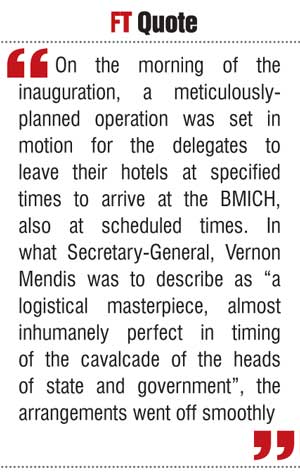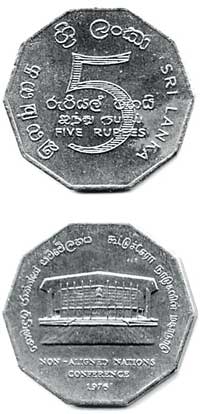Wednesday Dec 03, 2025
Wednesday Dec 03, 2025
Saturday, 13 August 2016 00:10 - - {{hitsCtrl.values.hits}}


Prime Minister addresses flanked by Governor-General William Gopallawa and Speaker Stanley Tillekeratne. Behind are Cabinet Ministers
By D.C. Ranatunga
Forty years ago – 16 August 1976. Over 80 flags are fluttering on the flag-posts at the entrance to the Bandaranaike Memorial International Conference Hall (BMICH). The first major international conference is held in Colombo at the first purpose built conference hall in Asia. A gift by the Chinese as a tribute to one of Sri Lanka’s great statesmen and a promoter of non-alignment, the BMICH had been opened three years earlier.
The occasion is the inauguration of the Fifth Conference of Heads of State or Government of Non-Aligned countries. Leaders of State/Government of 92 countries had arrived in Sri Lanka a couple of days earlier on the invitation of Prime Minister Sirimavo Bandaranaike, who was personally present at the airport to receive some of them. Among the leaders were Yugoslavia’s Marshal Tito, Zimbabwe’s Kenneth Kaunda, Cyprus’ Archbishop Makarios II, India’s Indira Gandhi, Syria’s Al Azad, Libya’s Colonel Qadafi and Egypt’s Anwar Sadat.
At the Fourth Conference held in Algiers in 1973 Sri Lanka was selected as the venue and the Ministry of Foreign Affairs meticulously planned to hold the Conference second to none. As reputed diplomat Jayantha Dhanapala wrote in ‘Sirimavo – Honouring the world’s first woman Prime Minister’, despite carping criticism by the opposition, the Conference was one of Sri Lanka’s greatest triumph in foreign policy. Detailed planning supervised personally by the Prime Minister, ensured its success, he added.
Senior career diplomats were picked to handle the key operations with Dr. Vernon Mendis, High Commissioner in London as Secretary-General of the Conference. Manel Abeysekera was in charge of protocol arrangements. Among others who handled the major aspects were Arthur Basnayake, Ben Foneka and Izzeth Husain. Senior members of the Administrative Service were also co-opted to handle responsible functions.
Manel Abeysekera wrote that Madam Bandaranaike’s decisive nature and the ability to guide and control affairs became very apparent. “She appointed a director-general to supervise and direct the officials in their individual areas of responsibility; and later based on the reports submitted to her by each official, personally monitored and guided the decision-making of the entire organising committee. As a result, the 5th NAM Summit, with 92 Heads of State/Government present, was one of the best organised NAM  Summits, if not the best,” she stated.
Summits, if not the best,” she stated.
Leelananda de Silva who was Secretary to the Economic Committee of the Summit, commented how the Prime Minister instructed to introduce a strong dimension to the NAM deliberations. She was most anxious not to confine the NAM Summit exclusively to the consideration of vexed political issues of the day. In her inaugural address she proposed that a Third World Commercial and Merchant Bank be established, a proposal that was to be followed by UNCTAD. With the change of government in 1977 the proposal was abandoned.
Leelanande de S mentions how she asked him to showcase the pioneering work in the field of pharmaceuticals initiated by Senaka Bibile, professor of pharmacology of the Peradeniya University. “Prod. Bibile’s outstanding work in helping to develop and promote cost-effective drugs policies, particularly in relation to the sider use of generic drugs, had been adopted by Sri Lanka. Although such policies as pioneered by Prof. Bibile is conventional wisdom today, it was revolutionary and path-breaking in the mid-1970s. Mrs. B, who know Prof. Bibile personally, requested me to include the professor in the Sri Lanka delegation and utilise his professional knowledge as relevant in the work of the economic committee. Thanks largely to the spade work done by Prof. Bibile at Mrs. B’s  instigation, it was possible for the Summit to adopt a key resolution on pharmaceutical policies in the Third World.”
instigation, it was possible for the Summit to adopt a key resolution on pharmaceutical policies in the Third World.”
The Colombo Summit was the first NAM Conference to be held in Asia. After the inaugural one was held in Belgrade in 1961, the others were in Cairo (1964), Lusaka (1970) and Algiers (1973). It was the 15th year since the formation of the Movement. The landmark event was marked with the release of a Rs. 5 coin by the Central Bank and two stamps of Rs 1.15 and Rs. 2 both carrying the portrait of Mrs. Bandaranaike. Ceylon Tobacco Company came out with a special brand of cigarettes – ‘Summit’ – in a gold-coloured pack. As manager in charge of public relations at CTC I coordinated the project for which we had to get clearance from the Prime Minister. I worked with Dr. Mackie Ratwatte, who was her private secretary, and he was most helpful in getting the clearance with the least possible delay.
A big contingent of media persons turned up to cover the event and if I remember, the Sri Lanka Foundation Institute which was quite close to BMICH was turned into a media site. Although television was not in Sri Lanka then, facilities were provided for media men to follow the proceedings through TV.
On the morning of the inauguration, a meticulously-planned operation was set in motion for the delegates to leave their hotels at specified times to arrive at the BMICH, also at scheduled times. In what Secretary-General, Vernon Mendis was to describe as “a logistical masterpiece, almost inhumanely perfect in timing of the cavalcade of the heads of state and government”, the arrangements went off smoothly. Both Governor-General William Gopallawa and the Prime Minister were present to receive the leaders, following the correct protocol procedure.
 Welcoming the delegates, Mrs. B delivered a fairly lengthy speech tracing the progress of the Movement and paying tribute to the leaders who started it and were no more. She said that the Colombo Summit symbolised the growing maturity of the Movement which having begun the search for a better world order, within a post-colonial context, had grown into a universal movement, solidly anchored in many continents.
Welcoming the delegates, Mrs. B delivered a fairly lengthy speech tracing the progress of the Movement and paying tribute to the leaders who started it and were no more. She said that the Colombo Summit symbolised the growing maturity of the Movement which having begun the search for a better world order, within a post-colonial context, had grown into a universal movement, solidly anchored in many continents.
Stressing that the Non-Aligned Movement does not constitute a new bloc, she described it as one which was founded on a categorical rejection of the system of power blocs. “Perhaps the sole reason for the existence of the Movement and its growing vitality is that it answers some compelling needs of people all over the world for a new outlook on life, for a new set of value based on mutual understanding and social awareness, equity and justice, in place of the old values which enthroned a ruthless and competitive individualism. If anything, Non-Alignment is a creative and constructive philosophy and all the world is all the better for it,” she declared.
She concluded her address saying: “The nations represented in this Assembly are heirs to great and ancient civilisations and cultures, and beneficiaries of teachings of all the major religions of the world, founded on peace, compassion and tolerance. As I invite you to the consideration of the many important issues on our Agenda, I am reminded of the words of one of the greatest philosophers and religious leaders of the world, the Buddha, who, in the course of his final discourse to the world said: ‘If we can meet together in concord, and rise in concord, and act upon our decisions in concord., so long may we be expected, not to decline, but to prosper.’
“I can do no better than to leave you with this thought for in many ways it sums up the philosophy of Non-Alignment itself with its tenets of peace, justice, goodwill and cooperation. It is also a clear enunciation of the most basic principle that should govern the conduct of human relations.”
Zambian President Kenneth Kaunda proposed the vote of thanks to Mrs. Bandaranaike.
To Secretary-General Mendis, “That was the day when I realised how proud we could be of our organisational resources, what our people, our officers and departments are capable of.”
